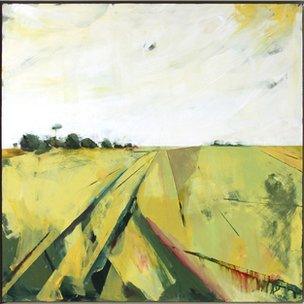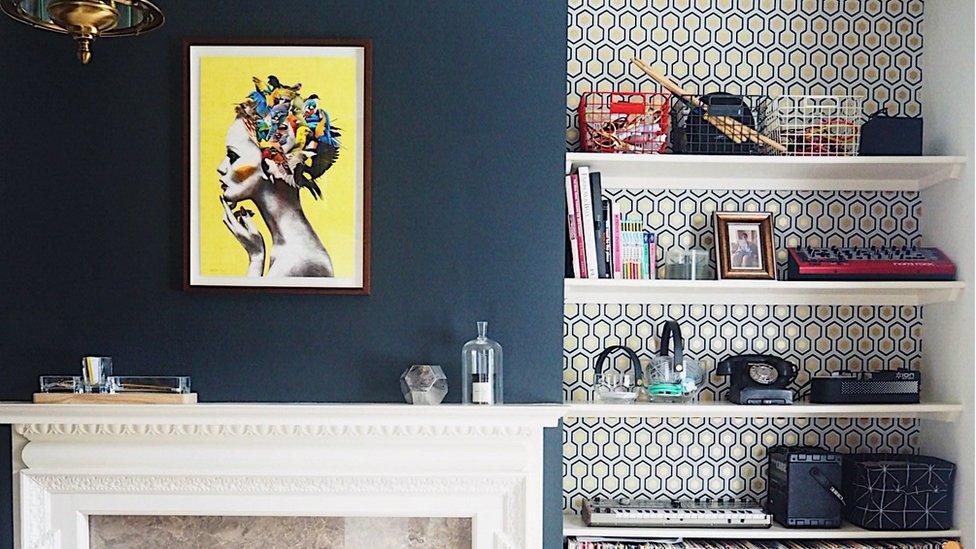'You don't have to be a squillionaire to buy art'
- Published

Online sites like Artfinder are enabling artists to market their works to bigger audiences
You don't have to spend millions of pounds to buy an original piece of art.
It's no longer just famous names who are selling their works. A growing number of art fairs and online marketplaces mean new artists starting out are also able to reach buyers well beyond their home markets.
"It's just a crazy time at the moment," says Alex Rotter, chairman of post-war and contemporary art at auction house Christie's, apologising for his late call.
We manage to speak just days before he kicks off the auction house's New York sale of 26 contemporary art works from husband-and-wife property development duo Jerry and Emily Spiegel.
This kind of single-owner collection "gathered with one breath", as Mr Rotter describes it, is rare.
The sale includes famous works by Christopher Wool and Sigmar Polke. With these two pieces valued at $20m (£15.5m) each, the 26 works are expected to raise $100m in total.

This Sigmar Polke raster dot painting is expected to sell for $20m
While the collection is being sold in New York, the top pieces have already been on a mini-world tour - travelling to Hong Kong, London and Los Angeles in a bid to drum up international interest.
"If you commit to buying a painting worth thousands of dollars then you want to see it first," says Mr Rotter.
Global art and antique sales totalled $57bn last year, down 11% on 2015, with the US dominating the marketplace, closely followed by the UK and China.
On a practical level, this means that delicate and often precious paintings have to travel thousands of miles without being damaged.
The value of Leonardo da Vinci's Lady with Ermine painting was considered so great that when it was sent from its Polish home to the US, it was reportedly given its own first-class plane seat, as well as an armed guard to make sure it reached its destination intact.
While this kind of treatment is exceptional, valuable paintings are typically transported in expensive protective crates complete with detectors to monitor humidity and temperature levels.

Paul West, whose landscapes are inspired by his Dorset roots, has sold several paintings overseas
British artist Paul West says that when he secured his first sale through online marketplace Artfinder to a buyer in Australia, his initial reaction was a joyous "yes", followed by a sinking realisation that he now had to get the piece there safely.
In the three years since he joined the website, Mr West has sold around 47 paintings, with almost a third of these to buyers in the US and Australia.
He recommends lots of bubble wrap and masking tape, and to tape sponge onto the corners.
So far his worst mishap has been a hold-up at customs, which meant a painting took a month rather than a week to reach its destination.
For the 52-year-old, selling outside the UK has broadened his opportunities.
"Access to the global market is a massive plus. I was producing work I was pleased with, but apart from art fairs, it was quite hard to be seen," he says.

Top artists may become famous, but most still struggle, says Artfinder founder Jonas Almgren
Artfinder founder and chief executive Jonas Almgren set up the service in 2013. He wanted to provide independent artists such as Mr West, who weren't already represented by a gallery, with a place to sell their work.
The online marketplace now features artists from 108 countries, with customers similarly global.
Originally a Silicon Valley software engineer, Mr Almgren subsequently spent a decade working in high-end galleries in New York, where a painting under $10,000 was considered affordable.
He says his experience taught him that most artists "just didn't have a chance" to succeed, and he wanted to change this.
The firm charges a 30% commission on all sales, and to address the obvious issue that it's hard to buy something so visual online, funds free returns.
Last year the firm sold £5m worth of paintings.

This year's Affordable Art Fair in London's Hampstead featured a dog portrait booth in response to the rise in demand for professional dog portraiture
The company has given him an insight into how global tastes differ.
While landscape and abstract paintings are popular everywhere, the UK particularly likes paintings of cats and dogs, he says. In contrast, US buyers prefer portraits and typically buy bigger paintings, probably because they tend to have bigger homes.
The pound's current weakness against the dollar also means that US buyers can afford to spend more on UK art.
But the most important thing, says Mr Almgren, is that his firm tries to cater for all tastes.
"A gallery always has a very strong taste. We've taken that model and turned it upside down," he says.

Rise Art uses technology to offer potential buyers recommendations based on what they've previously liked
Rise Art had similar ambitions to shake up the existing market. Set up in 2011, the start-up focuses on online sales, with prices from £200 to £30,000.
While online sales remain a small part of the overall global art market - less than 10% - reports suggest it's a growing area.
But founder and chief executive Scott Phillips admits that no matter how good the virtual images are, an artwork "always looks better in the flesh". To help buyers' confidence, the site enables them to rent artworks and live with a piece before committing.
The firm is much more selective than Artfinder, accepting only 1% to 5% of the artists who apply to sell via the site. Rise Art also charges a higher commission of 40%.

Rise Art also holds some "real world" exhibitions, such as this one in Hong Kong
Mr Phillips says websites like his are part of a new, more sensitive wave of disruptive firms. Unlike eBay and Amazon, which, he says, have commoditised products and been "a destructive power in some ways", Rise Art "celebrates creativity, giving artists a new vehicle for selling and showcasing their work".
While he's cagey on precise numbers, the firm now ships to 40 countries and revenue for the first three months of this year was 110% higher than a year ago.
The Affordable Art Fair (AAF) has experienced similarly rapid growth. Since starting out in London's Battersea Park in 1999, it now holds fairs in more than 10 cities around the world.

Affordable Art Fair founder Will Ramsay says you don't have to be rich to buy art
Founder Will Ramsay says the motivation behind the business was to prove that "you don't need to be a squillionaire to buy art".
While prices can be as high as £5,000 for a single painting, the AAF's average selling price in the UK is £600.
The firm makes its money by charging the galleries for the space they rent at its fairs, as well as through ticket prices and sponsors.
Recently, the firm has started online sales, an area Mr Ramsay sees as complementing the art fairs.
He owns two televisions - one to watch the video art he has accumulated and the other to watch normal TV. He says the 130 pieces of art he has collected are "memories through my life".
"Don't buy because you think it may go up in value," he advises would-be collectors, "but because you love it and want it on your wall at home."